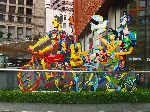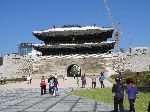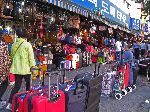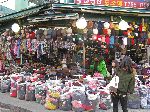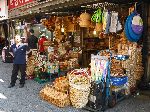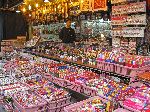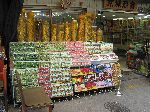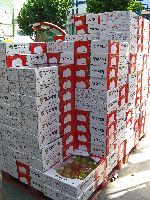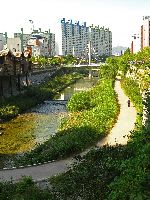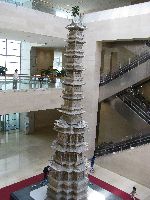Ibike Korea People-to-People Program
 Photo essay: Seoul
Walking Tour
Photo essay: Seoul
Walking Tour
Sample the sights of the ancient and modern capital of South Korea.
Points of Interest: Lots of temples and historic sites, museums and markets.
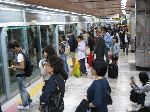
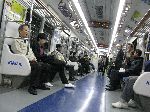 The
best way to get across Seoul is on the extensive subway system. It is clean,
smooth, comfortable, there is no graffiti. and on Sunday morning it is very
spacious. It is said that the subways are multi-purpose -- they can also server
as shelters should the north attack. In the center of town the corridors
continue between stations -- as linear shopping malls -- so in extreme weather
you can move around the city in climate controlled comfort.
The
best way to get across Seoul is on the extensive subway system. It is clean,
smooth, comfortable, there is no graffiti. and on Sunday morning it is very
spacious. It is said that the subways are multi-purpose -- they can also server
as shelters should the north attack. In the center of town the corridors
continue between stations -- as linear shopping malls -- so in extreme weather
you can move around the city in climate controlled comfort.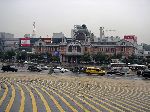
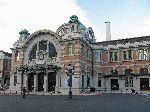 Emerging
from the subway system our first stop is Seoul Railroad Station. The old station
was constructed in 1926, by
the Japanese, is a Renaissance-style building with a Byzantine dome. A
multi-year restoration project was completed in 2011. The initial development of
the Korean rail system was started during the Japanese occupation. The
system now includes a comprehensive system of local, regional and high speed
inter-city trains.
Emerging
from the subway system our first stop is Seoul Railroad Station. The old station
was constructed in 1926, by
the Japanese, is a Renaissance-style building with a Byzantine dome. A
multi-year restoration project was completed in 2011. The initial development of
the Korean rail system was started during the Japanese occupation. The
system now includes a comprehensive system of local, regional and high speed
inter-city trains.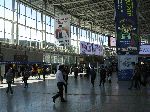
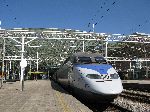 The
new station is a post-modern glass building. If you are looking for Korea's
bullet train this is where to look. Seoul Station is the northern terminus of
the KTX, the Korean bullet train.
The
new station is a post-modern glass building. If you are looking for Korea's
bullet train this is where to look. Seoul Station is the northern terminus of
the KTX, the Korean bullet train.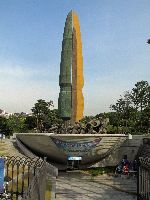
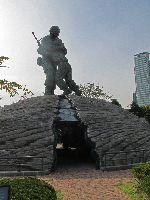
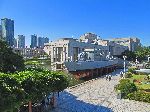
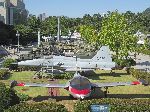 Here
are a few of the outside monuments at the National War Memorial of Korea.
There is also a vast array of military equipment on display (20 aircraft and
even more types of ground equipment) and six floors on inside displays.
Here
are a few of the outside monuments at the National War Memorial of Korea.
There is also a vast array of military equipment on display (20 aircraft and
even more types of ground equipment) and six floors on inside displays.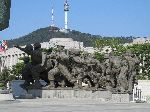
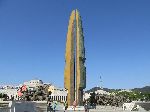
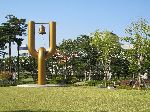
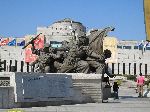
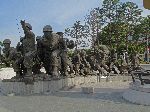
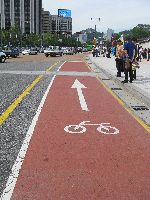
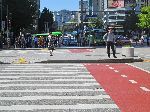
In recent years Seoul has made an effort to be more bicycle-friendly. A number of major arterials now have bike lanes, but the central city still has a ways to go before it is family-friendly for bicycling. The bike lane (right) is blocked by a pedestrian island. It is marked with a bicycle icon next to the curb. There are accessibility ramps serving the cross-walk.
(Click here for more details on the non-motorized infrastructure in Korea.)
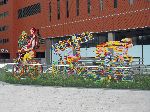
Perhaps to show
that they are in the spirit there is an installation of colorful, energetic, and fun
bicycle art. The sculptures appear to be by
David Gerstein, an Israeli
artist and
sculpture, who has similar pieces in other
public spaces around the world.
The pieces in Seoul are: (upper left): "Flower Girl Bike Rider", "Ladder Man"
and "Armstrong", (lower
left) "Troubadour
Bike Rider" and "Weekend Ride", and (right) "Country Rider". Also a part
of the Seoul installation, but not posted here are "Spring Bicycle Riders"
and "Rider in Euphoria".
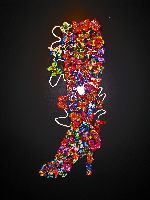
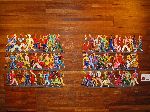
 As
a coincidence, I arrived at a hotel in Seoul that I regularly stay at and there
two new pieces by Gerstein hanging in the lobby. (The hotel has since been
demolished and the whereabouts of the lobby art is unknown.)
As
a coincidence, I arrived at a hotel in Seoul that I regularly stay at and there
two new pieces by Gerstein hanging in the lobby. (The hotel has since been
demolished and the whereabouts of the lobby art is unknown.)
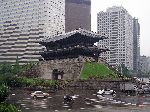
 Namdaemun (South Gate)
is appropriately named because it was literally the south gate into the city
through the old Fortress Wall.
Namdaemun is National Treasure number 1. What once marked the edge of the city has
long since been engulfed by it, but that hardly diminishes its elegance. In 2004, it sat inside a traffic circle (left) with five
lanes of traffic continually swirling around it. By 2006 it had been "rescued"
(upper right). All of the traffic is diverted to west flank of the gate
and pedestrians have access to the gate from the east. The regular
"changing of the guard" ceremony was restored, as well.
Namdaemun (South Gate)
is appropriately named because it was literally the south gate into the city
through the old Fortress Wall.
Namdaemun is National Treasure number 1. What once marked the edge of the city has
long since been engulfed by it, but that hardly diminishes its elegance. In 2004, it sat inside a traffic circle (left) with five
lanes of traffic continually swirling around it. By 2006 it had been "rescued"
(upper right). All of the traffic is diverted to west flank of the gate
and pedestrians have access to the gate from the east. The regular
"changing of the guard" ceremony was restored, as well.
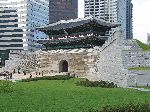
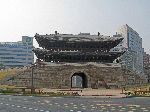 Ironically
its 'rescue' may have facilitated its demise because in 2010 it was
torched by an arsonist. To find, collect and properly cure the old growth
timber need for and authentic restoration of the structure took several years.
Fortunately the construction fences came down in 2013 and the gate is again
visible. While it is accessible to visitors, it is now difficult to get to
any part of it that might be flammable.
Ironically
its 'rescue' may have facilitated its demise because in 2010 it was
torched by an arsonist. To find, collect and properly cure the old growth
timber need for and authentic restoration of the structure took several years.
Fortunately the construction fences came down in 2013 and the gate is again
visible. While it is accessible to visitors, it is now difficult to get to
any part of it that might be flammable.
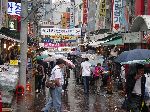
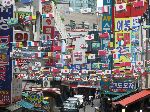 Just
inside the gate is Namdaemun Market. It seems to have
everything. Among the clearly identifiable sections are the fish arcade,
vegetable arcade, jewelry arcade, ginseng arcade, clock arcade and folk craft
arcade to name a few.
Just
inside the gate is Namdaemun Market. It seems to have
everything. Among the clearly identifiable sections are the fish arcade,
vegetable arcade, jewelry arcade, ginseng arcade, clock arcade and folk craft
arcade to name a few.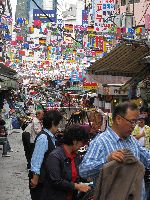
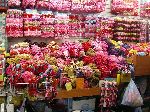 If
a shop has one of something it seemed to have an enormous number of
that item. And if there is one shop with a certain inventory there is probably
another shop with nearly the same inventory near by. In one shop (right) it was all about head bans and hair accessories, with the dominate
color of pink. Other shops would specialized in perfume, or shoes, or
socks, or belts, or hats or watches, or phones, or knives, or table settings, or crafts, or
ginseng and tea, packs and suitcases, hats and caps, baskets and fans, or
trinkets and souvenirs, and the list goes on.
If
a shop has one of something it seemed to have an enormous number of
that item. And if there is one shop with a certain inventory there is probably
another shop with nearly the same inventory near by. In one shop (right) it was all about head bans and hair accessories, with the dominate
color of pink. Other shops would specialized in perfume, or shoes, or
socks, or belts, or hats or watches, or phones, or knives, or table settings, or crafts, or
ginseng and tea, packs and suitcases, hats and caps, baskets and fans, or
trinkets and souvenirs, and the list goes on.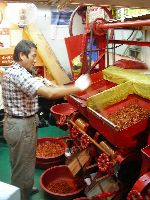
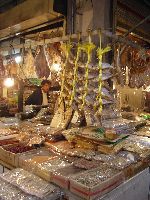 There
were several shops that
grind pepper in enormous quantities so that people don't run short of gochu, the main
spice for kimchi (left).
There
were several shops that
grind pepper in enormous quantities so that people don't run short of gochu, the main
spice for kimchi (left).
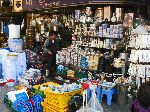
If you need a container, or pot, or pan, there is a shop for that (right)
Many shops have dried fish -- bagged and hanging -- ready for sale (far right).
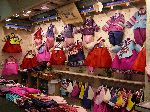
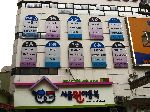 In
addition to the streets of storefront markets and kiosks, there are at least a
dozens "vertical malls" in the neighborhood. In one-story high signs this
building lists what you can find on each to the nine floors of the interior:
Wholesale flowers, children's clothes, ladies wear (two floors), accessories,
men's wear, shoes, "synthesis clothes" (two floors) and a restaurant.
In
addition to the streets of storefront markets and kiosks, there are at least a
dozens "vertical malls" in the neighborhood. In one-story high signs this
building lists what you can find on each to the nine floors of the interior:
Wholesale flowers, children's clothes, ladies wear (two floors), accessories,
men's wear, shoes, "synthesis clothes" (two floors) and a restaurant.
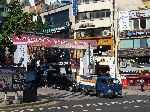
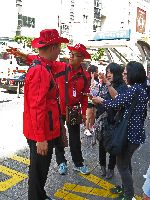 Adjacent
to Namdaemun Market is Myeongdong Market. It is considered more upscale and
fashionable. While more expensive, and presumably better quality, than Namdaemun,
it is considered to have good price when compared international, so it attracts
tourist-shoppers from Japan and other countries East Asia.
Adjacent
to Namdaemun Market is Myeongdong Market. It is considered more upscale and
fashionable. While more expensive, and presumably better quality, than Namdaemun,
it is considered to have good price when compared international, so it attracts
tourist-shoppers from Japan and other countries East Asia.To facilitate the shopping there are "shopping guides / translators", mostly with skills in Japanese, but some also wear badge for Chinese.
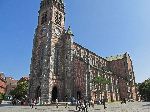
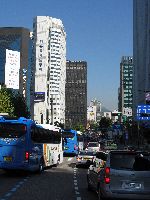
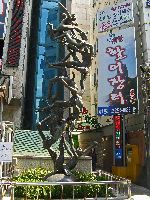
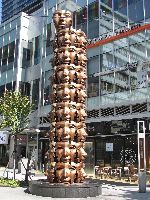
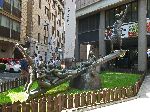 Myeongdong
is just on the edge of the one concentration of skyscrapers. Most of the
skyscrapers are International-style, and descent for the genre.
Myeongdong
is just on the edge of the one concentration of skyscrapers. Most of the
skyscrapers are International-style, and descent for the genre.Tucked between the skyscrapers are sculptures and pieces of art. Even the largest are dwarfed by the building and lost in the clutter. But if you can separate them out and focus on them, most have something to say.
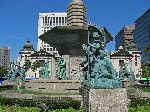
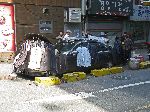 Also
in the canyons of Myeongdong, we came across what must be the epitome of a
pop-up market (right): To do this you drive your car in, park, POP open the hood and
trunk (or boot) and crack the windows, then hang your goods from every place (in
this case suits, suit-jackets and men's cloths), and voila, you have a market. A
Pop-up Market.
Also
in the canyons of Myeongdong, we came across what must be the epitome of a
pop-up market (right): To do this you drive your car in, park, POP open the hood and
trunk (or boot) and crack the windows, then hang your goods from every place (in
this case suits, suit-jackets and men's cloths), and voila, you have a market. A
Pop-up Market.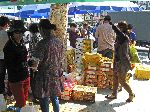
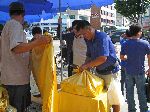 the market. It is also known a Han-Gawi. It is a day of thanksgiving for a
good harvest. As on Lunar New Year's Day (Korea's other major holiday), families
come home from all across the country to celebrate together. It is
customary to arrive with a gift.
Cases of many kinds of food are specially packaged for Chusok; cases of fruit
(apples, peaches, pears, grapes), cases of dried fish, cases of canned Spam, and
cases of sweets are some of the offerings. These are often wrapped in a
cloth.
the market. It is also known a Han-Gawi. It is a day of thanksgiving for a
good harvest. As on Lunar New Year's Day (Korea's other major holiday), families
come home from all across the country to celebrate together. It is
customary to arrive with a gift.
Cases of many kinds of food are specially packaged for Chusok; cases of fruit
(apples, peaches, pears, grapes), cases of dried fish, cases of canned Spam, and
cases of sweets are some of the offerings. These are often wrapped in a
cloth.At the home a feast is prepared by the woman and the men, and sometimes the family, will hold memorial services at the family gravesites. Viewing the full moon is a feature of the evening, when the Koreans would say, "The sky is high and the horse is fat." Families traditionally received new clothes on this day, but today they are more likely to just dress in tradition Korean hanbok. Faithfully they pay respects to their ancestors with wine, rice cakes, and newly harvested fruits and grains like chestnuts, jujubes, persimmons, apples and Korean pears. The day is not complete without the half-moon shapes rice cakes called songp'yon.
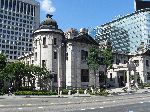
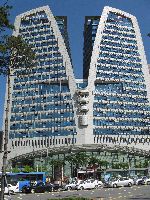
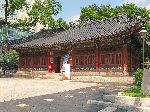 An now, across from the bank
building is Post Tower (left). It is one of a growing number of highly designed
skyscrapers in Seoul with multiple angles, curves and planes that probably
couldn't have been successfully designed and built prior to access to powerful
computers.
An now, across from the bank
building is Post Tower (left). It is one of a growing number of highly designed
skyscrapers in Seoul with multiple angles, curves and planes that probably
couldn't have been successfully designed and built prior to access to powerful
computers.Just for contrast, not far from Post Tower is the oldest post office in Korea. It now functions as a museum.

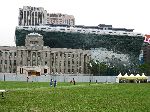 The old
(foreground) and new City Hall
(behind the old building in the photo to the right) demonstrate the contrast in
Seoul architecture. The old building is another example of neo-classic architecture (from
the Japanese occupation era) and the new modern glass international-style
building looks like a wave rising and enveloping the old building from behind.
The old
(foreground) and new City Hall
(behind the old building in the photo to the right) demonstrate the contrast in
Seoul architecture. The old building is another example of neo-classic architecture (from
the Japanese occupation era) and the new modern glass international-style
building looks like a wave rising and enveloping the old building from behind.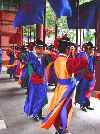
 Deoksugung
(Palace)
is a green sanctuary in the bustling city. It was originally (1454) a royal villa, but in 1593, when the Japanese burned the
main
palace, this became a temporary palace. From 1623 to 1897 it was not used as
a palace. After being forced to give up his throne in 1910,
again by the Japanese, Emperor Gojong
secluded himself here until his death in 1919. It is the smallest and
probably simplest palace in Seoul. One item of more interest is a sun dial
(upper right), with instructions.
Deoksugung
(Palace)
is a green sanctuary in the bustling city. It was originally (1454) a royal villa, but in 1593, when the Japanese burned the
main
palace, this became a temporary palace. From 1623 to 1897 it was not used as
a palace. After being forced to give up his throne in 1910,
again by the Japanese, Emperor Gojong
secluded himself here until his death in 1919. It is the smallest and
probably simplest palace in Seoul. One item of more interest is a sun dial
(upper right), with instructions.

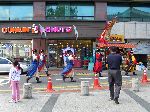
 It is a bit of cultural clash when the Joseon period royal guard turns the
corner and marches in front of the Dunkin Donut shop.
It is a bit of cultural clash when the Joseon period royal guard turns the
corner and marches in front of the Dunkin Donut shop.



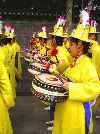
During one visit, this brightly, traditionally attired, all-girl marching, horn, flute, shell and drum corps joined other traditionally attired groups for a parade through Seoul, but I never learned the occasion.
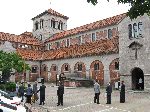
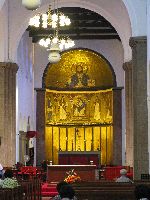
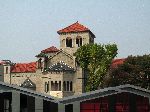 The
Anglican Church, in Seoul, was the first church building in Asia to be built in
typical Romanesque style. The apse and altar are Sicilian-style. The image, from
left to right, are: St Stephen the Martyr, St John the Evangelist, St Mary, The
Prophet Isaiah, and St Nicholas. Jesus Christ is above. The organ
has 20 stops and 1450 pipes.
The
Anglican Church, in Seoul, was the first church building in Asia to be built in
typical Romanesque style. The apse and altar are Sicilian-style. The image, from
left to right, are: St Stephen the Martyr, St John the Evangelist, St Mary, The
Prophet Isaiah, and St Nicholas. Jesus Christ is above. The organ
has 20 stops and 1450 pipes.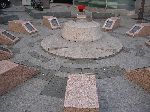
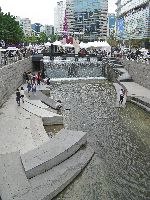
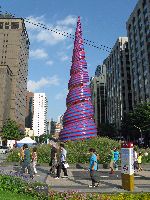
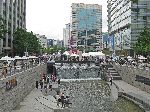 A
very inspiring pedestrian
and environmental quality
project in the heart of Seoul is the restoration of Cheonggye-cheon (stream). Through
the length of the project there are six section with distinct architectural and
landscape themes: History Zone, Cultural / Commercial Zone, Nature Zone, Harmony
Zone and Seoul Forest Park Zone. Even within most of the sections, every couple hundred meters the river-scape changes character, providing
hundreds of photogenic angles.
A
very inspiring pedestrian
and environmental quality
project in the heart of Seoul is the restoration of Cheonggye-cheon (stream). Through
the length of the project there are six section with distinct architectural and
landscape themes: History Zone, Cultural / Commercial Zone, Nature Zone, Harmony
Zone and Seoul Forest Park Zone. Even within most of the sections, every couple hundred meters the river-scape changes character, providing
hundreds of photogenic angles.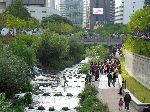
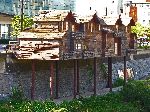
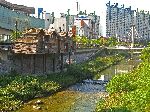 When
Seoul was just a village and small town, kids played in the stream and women did laundry
on the river bank.
After the Korean War, people seeking a better life in Seoul immigrated from the countryside.
They built makeshift
houses along and cantilevered over the stream. This had a heavy
impact on the water quality of the stream and filled the channel with garbage.
When
Seoul was just a village and small town, kids played in the stream and women did laundry
on the river bank.
After the Korean War, people seeking a better life in Seoul immigrated from the countryside.
They built makeshift
houses along and cantilevered over the stream. This had a heavy
impact on the water quality of the stream and filled the channel with garbage.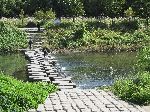
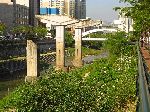
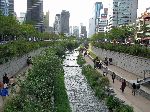 In the 1960's a
series of project cleared the low-cost housing, encase the polluted
stream in concrete culverts and build an elevated highway over it. This was the measure of progress of
the day. (A few of the support pillars for the highway have been left
standing.)
In the 1960's a
series of project cleared the low-cost housing, encase the polluted
stream in concrete culverts and build an elevated highway over it. This was the measure of progress of
the day. (A few of the support pillars for the highway have been left
standing.)
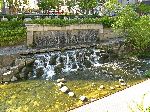
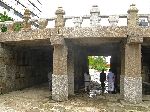 Forty years later
the vision and local priorities changed
again, this time placing greater
values on aesthetics and the natural environment, and preserving the heritage of
the city. The day-lighting of the stream, removal of the highway,
restoration of old bridges
and installation of riverside walks, waterfalls and public art was completed in October 2005.
A open stream with crystal clear water now flows between the
canyon of skyscrapers and out of the heart of the city.
Each block of the stream and river bank changes character -- generally
progressing from more formal and designed to more natural and random. Along the walkways
are exhibits and art installation the commemorate the history of the country,
city and stream.
Forty years later
the vision and local priorities changed
again, this time placing greater
values on aesthetics and the natural environment, and preserving the heritage of
the city. The day-lighting of the stream, removal of the highway,
restoration of old bridges
and installation of riverside walks, waterfalls and public art was completed in October 2005.
A open stream with crystal clear water now flows between the
canyon of skyscrapers and out of the heart of the city.
Each block of the stream and river bank changes character -- generally
progressing from more formal and designed to more natural and random. Along the walkways
are exhibits and art installation the commemorate the history of the country,
city and stream.
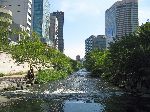
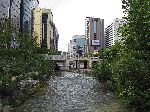
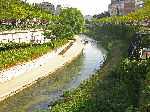
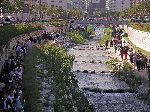
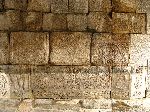
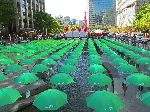
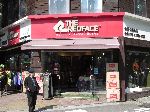
Around the head of Cheonggye-cheon, there is to be a full program of events and art installations. It is rare that there is not a stage in the plaza and pop-up tents around the edges. And one October, a block of the river was covered with green umbrellas.
Above Cheonggye-cheon, the road are still lined with markets. Some of the names of the business will prompt you to do a double-take, like the Red Face outdoor equipment store (left).
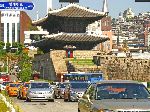
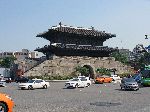 If
you continue far enough along Cheonggye-cheon you will come to the ancient
Dongdaemun (the east gate) (left). Once part of the City Fortress Wall
that encircled the city, it is now tucked into and engulfed by the city.
If
you continue far enough along Cheonggye-cheon you will come to the ancient
Dongdaemun (the east gate) (left). Once part of the City Fortress Wall
that encircled the city, it is now tucked into and engulfed by the city. 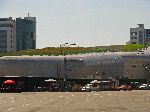
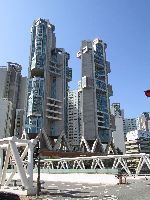
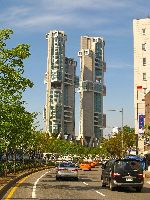 Opposite
sublime tradition Dongdaemun (gate)
is the neo-futuristic Dongdaemun Design Plaza, with a living room (green roof) (left).
It was designed by the award-winning and controversial Iraqi-British architect,
Zaha Hadid. Many of her designs were considered so extravagant and expensive
they were never built. But she has a long list of successful projects. This
project is not usually even on the list of her most notable.
Opposite
sublime tradition Dongdaemun (gate)
is the neo-futuristic Dongdaemun Design Plaza, with a living room (green roof) (left).
It was designed by the award-winning and controversial Iraqi-British architect,
Zaha Hadid. Many of her designs were considered so extravagant and expensive
they were never built. But she has a long list of successful projects. This
project is not usually even on the list of her most notable.To add to the architectural diversity, not far away a high rise residential building which might have been inspired by the designers earlier play with Legos.
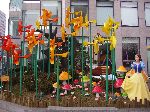
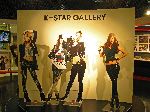
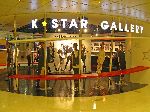 The main information center for the Korean Tourism Organization is also along Cheonggye-cheon.
Among the resources there is a permanent exhibit called the K-Star Gallery, with
larger-than-life cut-outs of Korean entertainment stars.
The main information center for the Korean Tourism Organization is also along Cheonggye-cheon.
Among the resources there is a permanent exhibit called the K-Star Gallery, with
larger-than-life cut-outs of Korean entertainment stars.
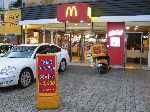
Conspicuously absent
for this essay is a discussion of coffee shops in Seoul (and all
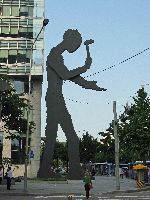 the
large cities of Korea.) Anyone who has been to Seoul knows this is a distortion.
There is a coffee shop on almost every block. To rectify this we have made
a special page on Coffee in Korea.
the
large cities of Korea.) Anyone who has been to Seoul knows this is a distortion.
There is a coffee shop on almost every block. To rectify this we have made
a special page on Coffee in Korea.
To be part of the international scene, Seoul also has a "Hammering Man". The piece was done by Boston born Jonathan Borofsky. Borofsky has sold nearly identical sculptures to at least Basel, Seattle, and Frankfurt -- they differ only in height. Seoul's is 72 feet tall, which makes it one of the tallest. The sculpture is said to celebrate the workers contribution to the city's history. The arm with the hammer move continuously up and down.
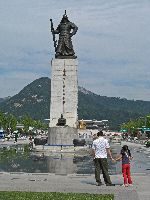
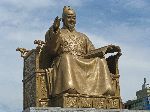 Prominently
in the median of Sejong-ro, there are larger than life statues to the larger
than life Korean national heroes Admiral Lee Seun Sin and Emperor Sejongno Road.
Admiral Lee undermined the Japanese invasion (1592-98) with his "turtle ships"
that reeked havoc with Japanese supply lines. Emperor Sejong, among many
accomplishments, revived the Chiphyonjon, Royal Academy. It started with a staff
of 10 and grew to 20 and development Hangul script and many scientific
instruments.
Prominently
in the median of Sejong-ro, there are larger than life statues to the larger
than life Korean national heroes Admiral Lee Seun Sin and Emperor Sejongno Road.
Admiral Lee undermined the Japanese invasion (1592-98) with his "turtle ships"
that reeked havoc with Japanese supply lines. Emperor Sejong, among many
accomplishments, revived the Chiphyonjon, Royal Academy. It started with a staff
of 10 and grew to 20 and development Hangul script and many scientific
instruments.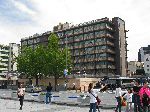
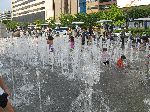 Also prominent on
Sejong
Road is the 24/7/365 guarded U.S. Embassy. It is not with just a few
sentries, but armored military vehicles and a detachment of riot police camped
along the wall. Some of this is visible in the lower right of the photo.
It is pretty much ignored by the tourists.
Also prominent on
Sejong
Road is the 24/7/365 guarded U.S. Embassy. It is not with just a few
sentries, but armored military vehicles and a detachment of riot police camped
along the wall. Some of this is visible in the lower right of the photo.
It is pretty much ignored by the tourists.In the median of Sejong-ro, almost across the street from the U.S. Embassy children frolic in the fountain on warm days.
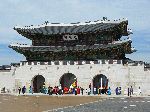
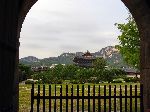 Gyeongbokgung, built
in 1395, was the primary palace of the
Joseon Dynasty. While it has a resemblance to the Forbidden City in
Beijing, much of it has been destroyed. It was never as large as
the Forbidden City because Korea was generally subservient to China and had to
show deference. This is Gwanghwamun (gate) and the palace wall.
Gyeongbokgung, built
in 1395, was the primary palace of the
Joseon Dynasty. While it has a resemblance to the Forbidden City in
Beijing, much of it has been destroyed. It was never as large as
the Forbidden City because Korea was generally subservient to China and had to
show deference. This is Gwanghwamun (gate) and the palace wall.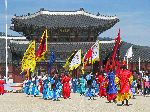
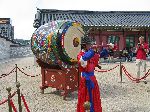
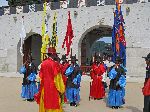
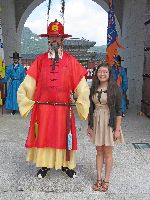 During the day, weather permitting, there are
ceremonies for the opening and closing of the palace gates, and twelve, hourly Changing-of- the-Gate-Guards, with several variations.
During the day, weather permitting, there are
ceremonies for the opening and closing of the palace gates, and twelve, hourly Changing-of- the-Gate-Guards, with several variations.When the guards are in position they are happy to stoically pose for pictures with the tourists -- individuals or groups. There is no one keeping order for this process so if there are a lot of tourists it can be very competitive to be the next person saddled up to the guard for the photo-op.
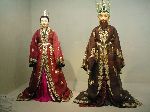
One of the exhibits is on the history of the Hanbok. It is fascinating to see the evolution of the style. Even today the cut and color change from year to year like any fashion trend. The common denominator seems to be high wasted belt or tie.
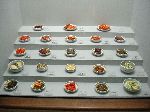
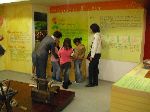
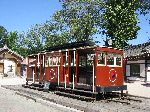 Incorporated
into the National Folk Museum is a hands-on children's museum. The is also an outdoor section to the
museum with traditional children's games and a replica of a 1950's Seoul street.
Incorporated
into the National Folk Museum is a hands-on children's museum. The is also an outdoor section to the
museum with traditional children's games and a replica of a 1950's Seoul street.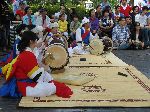
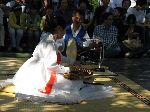
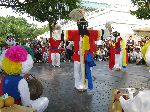
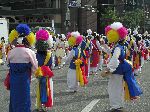 In
time it may change, but I am amazed at how often I happen upon
public performances of traditional Korean music and dance in Seoul. They happen
at museums, palaces, on the boulevards and in the public square. The Koreans in the
audience seem as thrilled as the non-Koreans.
In
time it may change, but I am amazed at how often I happen upon
public performances of traditional Korean music and dance in Seoul. They happen
at museums, palaces, on the boulevards and in the public square. The Koreans in the
audience seem as thrilled as the non-Koreans.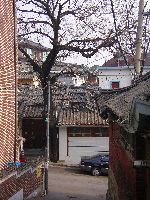
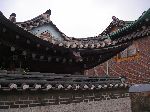
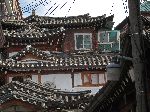 Bukchon
(north village) was a residential area of high government officials during the
Joseon Period. After the fall of the Joseon Dynasty and the occupation by
the Japanese, Bukchon fell on hard times. As the old traditional hanok,
wooden houses, became derelict they were replaced by less traditional
structures. There is now a resurgence in appreciation for the hanok that
has lead to effort to preserve the remaining few. Bukchon has a higher
concentration of hanok than any other part of the city and has become
famous for this. It has again become a fashionable address.
Bukchon
(north village) was a residential area of high government officials during the
Joseon Period. After the fall of the Joseon Dynasty and the occupation by
the Japanese, Bukchon fell on hard times. As the old traditional hanok,
wooden houses, became derelict they were replaced by less traditional
structures. There is now a resurgence in appreciation for the hanok that
has lead to effort to preserve the remaining few. Bukchon has a higher
concentration of hanok than any other part of the city and has become
famous for this. It has again become a fashionable address.
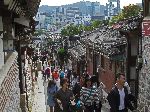
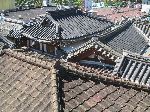
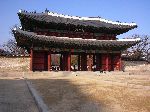
Donhwanmun Gate, the oldest palace gate among those remaining in Korea.
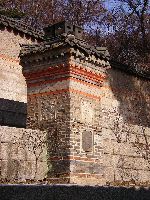
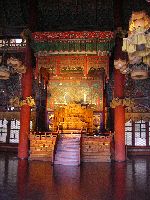 Changdeokgung
was the 2nd palace for a long period. After the Imjin
Invasion (1592-98), Changdeokgung was the first rebuilt and was used as the main palace until until 1865, in the late
Joseon Dynasty. A special feature of Changdoekgung is its royal garden.
Changdeokgung
was the 2nd palace for a long period. After the Imjin
Invasion (1592-98), Changdeokgung was the first rebuilt and was used as the main palace until until 1865, in the late
Joseon Dynasty. A special feature of Changdoekgung is its royal garden.Changdeokgung has many of the elements of Gyeongbokgung, the big palace, on a lesser scale.
Click here for a walking tour of Changdeokgung & the Secret Garden
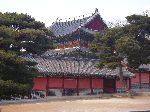
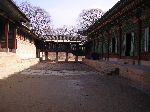
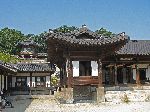
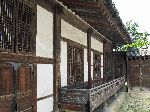
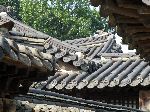
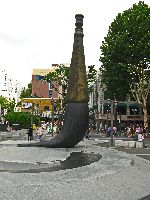
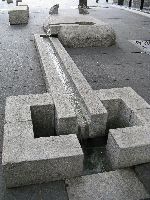
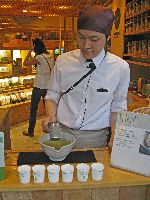
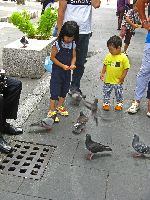
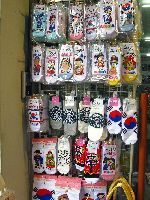
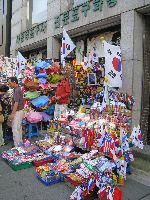
The new era has produced a spruced up streetscape and street art, but the new stores inventories tend toward universal fast food, tourist nick-knacks, logo wear, designer fashion, etcetera -- but they keep the street filled with people.
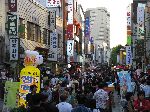
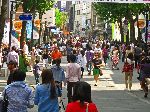
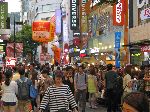
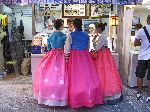
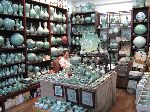
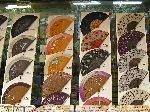 Celadon
pottery shop. Celadon is pale-jade-green pottery, made from white clay with a
small iron content. It is coated with a ferric feldspar dirt glaze and
fired at 1300oC. The process was refined from the 10th to 12th
century. Celadon's high quality was favored by the royal family.
Celadon
pottery shop. Celadon is pale-jade-green pottery, made from white clay with a
small iron content. It is coated with a ferric feldspar dirt glaze and
fired at 1300oC. The process was refined from the 10th to 12th
century. Celadon's high quality was favored by the royal family.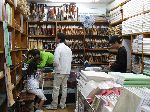
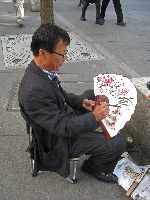 Calligraphy
brush and paper shop.
Calligraphy
brush and paper shop.
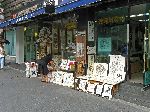 There are still a few artist in the area practicing
their trade, as exemplified by the man to the right hand-painting fans.
There are still a few artist in the area practicing
their trade, as exemplified by the man to the right hand-painting fans.
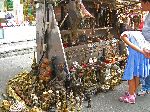
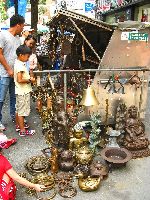 Into
the first decade of the new millennium there were antique dealers in the store
fronts along the main streets. These have now been pushed to shops on the
side streets and a couple of temporary sales kiosks on the main street.
Into
the first decade of the new millennium there were antique dealers in the store
fronts along the main streets. These have now been pushed to shops on the
side streets and a couple of temporary sales kiosks on the main street.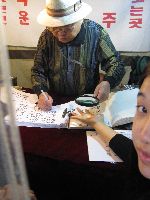
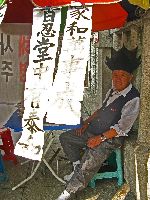 These fortune tellers was
two in a line of about a dozen fortune teller booths at the end of Insa-dong
street. There are both male
and female fortune tellers, and they seem to use a variety of techniques, such
as palm reading, tarot cards and others.
These fortune tellers was
two in a line of about a dozen fortune teller booths at the end of Insa-dong
street. There are both male
and female fortune tellers, and they seem to use a variety of techniques, such
as palm reading, tarot cards and others.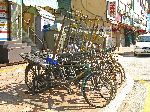
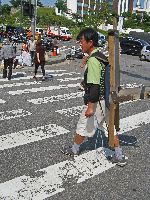
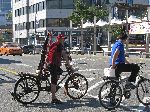 Seoul is full of narrow streets and tightly packed market areas.
Two of
the long standing modes for moving goods in and around the markets are by back
pack and cargo
bikes. The bikes have a long wheel base that is achieved by lengthening
all of the horizontal tubes. To correct the distance between the saddle
and the handlebars, the seat post is a goose-neck that extends forward and
supported by additional brasing. The platform on the back is large enough
to carry a medium-size refrigerator, which has probably been done.
Seoul is full of narrow streets and tightly packed market areas.
Two of
the long standing modes for moving goods in and around the markets are by back
pack and cargo
bikes. The bikes have a long wheel base that is achieved by lengthening
all of the horizontal tubes. To correct the distance between the saddle
and the handlebars, the seat post is a goose-neck that extends forward and
supported by additional brasing. The platform on the back is large enough
to carry a medium-size refrigerator, which has probably been done.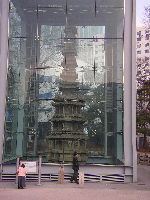
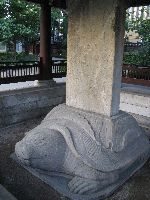
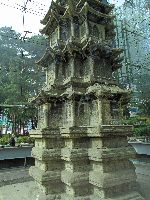 Tapgol
(Pagoda) Park was the first modern park in Seoul. The primary pieces were
recovered from the site of Wongak-sa, a Joseon era temple -- since destroyed. The park gets it name from the
intricately carved, ten-story,
12m high, marble
pagoda that was moved to the park. It was originally 13 stories. The
monument to the right describes the history of the construction of Wongak-sa.
Granite turtle base, with a marble body stone and head stone. The park is historically prominent because it
is the birth place of Korea's modern Independence Movement. On March 1,
1919, during the Japanese
occupation, 400-500 students gathered
here to hear the first reading of the Korean Declaration of Independence.
Tapgol
(Pagoda) Park was the first modern park in Seoul. The primary pieces were
recovered from the site of Wongak-sa, a Joseon era temple -- since destroyed. The park gets it name from the
intricately carved, ten-story,
12m high, marble
pagoda that was moved to the park. It was originally 13 stories. The
monument to the right describes the history of the construction of Wongak-sa.
Granite turtle base, with a marble body stone and head stone. The park is historically prominent because it
is the birth place of Korea's modern Independence Movement. On March 1,
1919, during the Japanese
occupation, 400-500 students gathered
here to hear the first reading of the Korean Declaration of Independence.
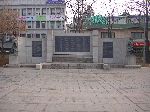
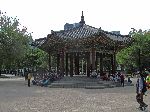
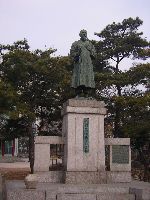
On a back street, a few blocks from Tapgol Park, is Mahabodhi-sa (temple). The temple was built by Zen Master Yong Sung for the Independence of Korea from Japanese occupation. At age 48 he devoted himself to the cause for the next 29 years.
 Zen
Master Yong Sung brought the land to build the temple, which became the
headquarters of the Independence movement. In 1912, Zen Master Yong Sung met Mr.
Kim Gu, age 32. Seven years later Kim Gu was imprisoned for his active
participation in the Independence Movement. He escaped from prison and
later became an ordained Buddhist monk at Magoksa, where he practiced for three
years before he became a layman. Kim Gu stayed at Daegaksa whenever he was in
Seoul. Having been greatly influenced by the Zen Master Yong Sung, Kim Gu
decided to dedicate his life to the independence of Korea. When Kim Gu was
exiled to Shanghai for his activities, Zen Master Yong Sung provided the funds
to support his activities.
Zen
Master Yong Sung brought the land to build the temple, which became the
headquarters of the Independence movement. In 1912, Zen Master Yong Sung met Mr.
Kim Gu, age 32. Seven years later Kim Gu was imprisoned for his active
participation in the Independence Movement. He escaped from prison and
later became an ordained Buddhist monk at Magoksa, where he practiced for three
years before he became a layman. Kim Gu stayed at Daegaksa whenever he was in
Seoul. Having been greatly influenced by the Zen Master Yong Sung, Kim Gu
decided to dedicate his life to the independence of Korea. When Kim Gu was
exiled to Shanghai for his activities, Zen Master Yong Sung provided the funds
to support his activities.
On March 1, 1919, the 33 representatives of the Independence Movement, including Zen Master Yong Sung, declared Korea's independence at Tapgol Park. He was imprisoned for two years as a result. Upon his release, Zen Master Yong Sung continued to secretly take part in the Independence Movement while translating Buddhist scriptures and teaching the Dharma to the public. He also purchased an orchard in Hamyang, Gyeongsang Province, and another one in Yongjung, Manchuria, to raise money to support the Independence Army in Manchuria. In retaliation, the Japanese confiscated the private property owned by Mahabodhi-sa in 1931.
Zen Master Yong Sung passed away on February 24, 1940, at Mahabodhi-sa. His relics (Sari) are preserved in Haein-sa. Mahabodhi-sa is a Mecca of Buddhist teaching and March 1 Independence Movement.
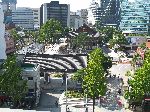
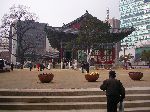
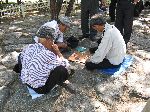 Jogyesa Temple,
headquarters of Korean Buddhism.
Jogyesa Temple,
headquarters of Korean Buddhism.Not far away, in the shade of a park, the men's club has gathered to pass the day.
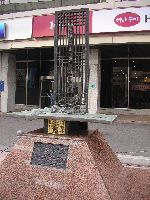
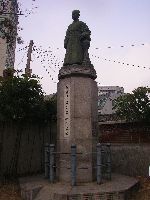 The
monument (left) is at Ri Insik's house, where general, civil servant and
activist Min Young-Hwan (b. 1861) committed suicide on November 30, 1905, after
leading resistance to capitulation to the invasion by the Japanese. The
statue of Min (right) is near Bongeun-sa.
The
monument (left) is at Ri Insik's house, where general, civil servant and
activist Min Young-Hwan (b. 1861) committed suicide on November 30, 1905, after
leading resistance to capitulation to the invasion by the Japanese. The
statue of Min (right) is near Bongeun-sa.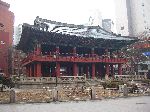
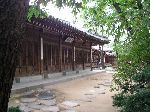
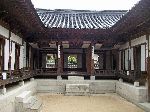
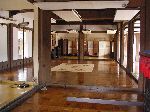
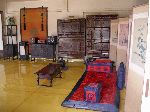 House of Bumadowi (title given to a king's son-in-law) Bak; House of Owijang
(Commander of Five Commanders') Kim; and, House of Dopyeonsu (Master Architect)
Yi.
House of Bumadowi (title given to a king's son-in-law) Bak; House of Owijang
(Commander of Five Commanders') Kim; and, House of Dopyeonsu (Master Architect)
Yi.This is one of the interiors, with period pieces at Namsangol Hanok (traditional) Village, Seoul
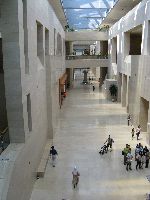
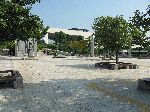
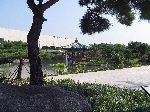
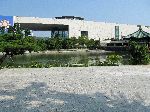
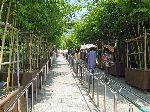
The National Museum of Korea is the flagship museum of Korean history and art in South Korea. Since its establishment in 1945, the museum has been involved in studies and research activities in the fields of archaeology, history, and art. In 2005 the museum relocated to a new building in Yongsan District.
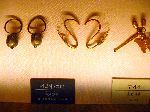
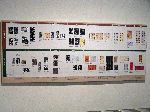 The
second floor contains the Donation Gallery and the Calligraphy and Painting
Gallery, which contains 890 pieces of art that showcase the traditional and
religious arts of Korea in line and color. The Calligraphy and Painting Gallery
is divided into four rooms: the Painting Room, the Calligraphy Room, the
Buddhist Paintings Room, and the Sarangbang (Scholar's Studio).
The
second floor contains the Donation Gallery and the Calligraphy and Painting
Gallery, which contains 890 pieces of art that showcase the traditional and
religious arts of Korea in line and color. The Calligraphy and Painting Gallery
is divided into four rooms: the Painting Room, the Calligraphy Room, the
Buddhist Paintings Room, and the Sarangbang (Scholar's Studio).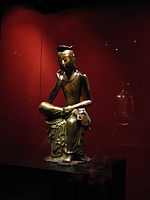
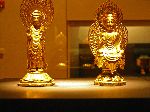 The
third floor contains the Sculpture and Crafts Gallery, with 630 pieces that
represent Korean Buddhist sculpture and craftwork. Highlights of the gallery
include Goryeo Celadon wares and National Treasure of Korea No. 83,
Bangasayusang (or Pensive Bodhisattva). The five rooms of the gallery are the
Metal Arts Room, the Celadon Room, the Buncheong Ware Room, the White Porcelain
Room, and the Buddhist Sculpture Room.
The
third floor contains the Sculpture and Crafts Gallery, with 630 pieces that
represent Korean Buddhist sculpture and craftwork. Highlights of the gallery
include Goryeo Celadon wares and National Treasure of Korea No. 83,
Bangasayusang (or Pensive Bodhisattva). The five rooms of the gallery are the
Metal Arts Room, the Celadon Room, the Buncheong Ware Room, the White Porcelain
Room, and the Buddhist Sculpture Room.Also on the third floor is the Asian Arts Gallery, which contains 970 pieces that explore the similarities and divergences of Asian art and the confluence of Asian and Western art via the Silk Road. The five rooms are the Indian & Southeast Asian Art Room, the Central Asian Art Room, the Chinese Art Room, the Sinan Undersea Relics Room, and the Japanese Art Room.
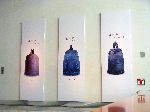
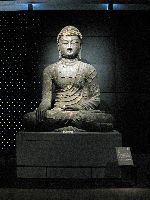
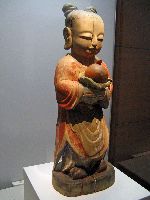
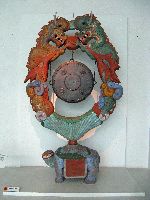
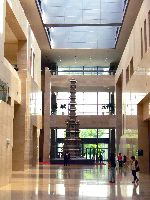
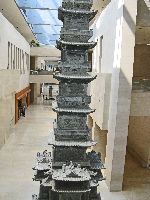 Within
the museum is Gyeongcheonsa Pagoda, National Treasure of Korea No. 86.
Within
the museum is Gyeongcheonsa Pagoda, National Treasure of Korea No. 86.
An inscription on the first story of the pagoda states that it was erected in the fourth year of King Chungmok in 1348. The pagoda was first placed at the now-lost Gyeongcheonsa Temple which sat at the foot of Mt. Buso in Gwangdeok-myeon, Gaepung-gun, Gyeonggi-do Province. During the Japanese occupation of Korea, the pagoda was taken to Japan. In 1960, the pagoda was returned and placed on the grounds of Gyeongbokgung Palace.
The pagoda stands 13 m in height and is ten stories tall. However, because of the three-tiered foundation, it is a common mistake to believe that the pagoda has thirteen stories. Unlike most Goryeo-era pagodas, this pagoda is made from marble. The preferred material of Korean sculptors was generally granite.
Gyeongcheonsa Pagoda sits on a three-tiered foundation which projects in four directions like a cross. The first three stories of the pagoda share the same shape as the foundation. Each panel of this tiered foundation is carved with Buddhas, Bodhisattvas, flowers, and arabesque patterns.
The remaining storeys are square in shape and share intricate detailing which tries to create the illusion that the marble pagoda is made from wood. Each remaining storey has railings, a hip-and-gabled roof, eaves, and carvings made to suggest that each roof is tiled.
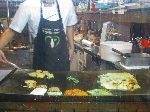
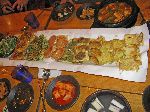 If the Italians
got the idea for pizza from Korea it was from panjeon. (The suggestion is only
because Marco Polo brought the concept of pasta from Asia back to Italy.)
A better similitude for jeon is a cross between a pancake and tempura. Jeons are made from
a variety of vegetables and / or seafoods fried in a light batter. They can take
many forms. The cook on the left is preparing and the platter to the right has
modeum jeon -- assorted pancakes.
If the Italians
got the idea for pizza from Korea it was from panjeon. (The suggestion is only
because Marco Polo brought the concept of pasta from Asia back to Italy.)
A better similitude for jeon is a cross between a pancake and tempura. Jeons are made from
a variety of vegetables and / or seafoods fried in a light batter. They can take
many forms. The cook on the left is preparing and the platter to the right has
modeum jeon -- assorted pancakes.
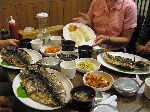
![]() Han River Trail: Incheon to Seoul.
Han River Trail: Incheon to Seoul.
![]() Seoul to Pallang (Cultural
Heartland, Four Rivers, and Exploring Eastern Korea)
Seoul to Pallang (Cultural
Heartland, Four Rivers, and Exploring Eastern Korea)
 Please
contact us if you would like to be added to
Ibike's mailing list or have questions, comments, corrections or criticism. (Also, please let us know how you learned about us and
found this site.) Privacy policy.
Please
contact us if you would like to be added to
Ibike's mailing list or have questions, comments, corrections or criticism. (Also, please let us know how you learned about us and
found this site.) Privacy policy.
![]() IBF Homepage
IBF Homepage ![]() Ibike Programs
Ibike Programs
![]() Ibike Schedule
Ibike Schedule
![]() Search
Search
